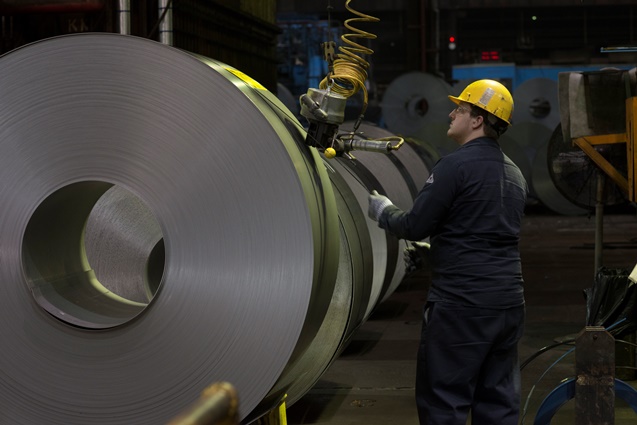
Steel execs and labor leaders tell Congress “not to blink.”
It’s been about a year since the Trump administration implemented its “Section 232” trade action, and steel industry officials told Congress on Wednesday they are seeing the positive effects — investments in facilities across the country, thousands of new jobs, raising wages, and even small business growth in local communities.
But nobody is breaking out the champagne quite yet.
“Right now, the steel industry is in what I would call recovery. Times are better than they’ve been in a long time,” said Leo Gerard, international president of the United Steelworkers. “But let me just say this: Chinese overcapacity still exists… We can’t sit idly by and think that just because things appear to be good they’re going to be good forever. We’ve got to make the recognition that the cheaters still exist.”
The labor leader’s message was echoed by steel executives who also testified at the annual Congressional Steel Caucus hearing. Officials from steel companies and associations noted that tariffs placed on steel imports have allowed the industry to finally begin to stabilize after facing an onslaught of unfairly traded imports, mainly from China.
The 232 tariffs have led to a decrease in imports and an uptick in domestic production. More than 12,000 new jobs have been announced across the steel and aluminum industries since the 232 investigation launched; $18.2 billion in investments also have been announced. Recent bargaining agreements between the Steelworkers union and several companies have led to raises and even bonuses for tens of thousands of workers.
U.S. Steel, for example, is investing at in several facilities across the country. In Granite City, Ill., the company restarted two blast furnaces that had sat idle since 2015, creating 800 jobs. In Lone Star, Texas, 140 new workers will soon be making products at a tubular mill that shut down in 2016. In Fairfield, Ala., the company is resuming construction of an electric arc furnace, a project placed on hold in 2015. About 600 workers will help build it, and 150 new employees will run it.
“We can’t sit idly by and think that just because things appear to be good they’re going to be good forever. We’ve got to make the recognition that the cheaters still exist.” Leo Gerard, international president of the United Steelworkers
Additional investments are being made at other U.S. Steel plants. But despite reason for optimism, CEO David Burritt cautioned that “now is not the time to blink.”
“No one should be lulled into thinking the job of the Section 232 is complete because the U.S. industry has touched an 80 percent capacity utilization level for a few weeks — a level it hasn’t reached in a decade,” Burritt testified. “This is not a temporary peak to be climbed, celebrated and abandoned — it’s a plateau to be sustained as the bare minimum level necessary for the industry to survive.”
ArcelorMittal USA President and CEO John Brett — whose company invested more than $392 million on its U.S. projects in 2018 — told Members of Congress that “if global steel demand softens, the U.S. market will be the destination of choice, as always, putting the investments and expansion under way in the United States at risk.”
There are a number of things that can be done to further strengthen the U.S. steel industry, officials agreed. Additional trade enforcement efforts would be especially helpful, including addressing efforts by countries like China to circumvent tariffs and maintaining the Section 232 trade tool, along with keeping the tariffs in place while the industry continues to stabilize.
John Ferriola, president and CEO of the Nucor Corporation, noted that “doomsday predictions about the tariffs have failed to materialize.”
“Just look at the statistics — last year was one of the best for U.S. manufacturing in a long time,” Ferriola said. “Profits for the sector were the highest they have been in the last 20 years. Manufacturing had its biggest net jobs gain since 1997. Blue collar wages are up, and unemployment is at a 50-year low.”
Passing a major infrastructure investment package — along with strong Buy America provisions that ensure the iron and steel used in infrastructure projects will be American-made — also will create demand and further strengthen the industry, officials agreed. “Please let this year be the time to stop talking and start investing,” Brett said.
Members of Congress appeared responsive to industry concerns.
Caucus Vice-Chair Rep. Mike Bost (R-Ill.), whose district includes U.S. Steel’s Granite City Works facility, said the 232 action strengthened America’s national security and created hundreds of jobs in his district alone.
Rep. Conor Lamb (D-Pa.), who took over as chair of the bipartisan caucus at the start of this congressional session, noted that while there has been debate over the impact of the steel tariffs, there is widespread agreement that China’s continued steel overcapacity is unacceptable. And Rep. Pete Visclosky (D-Ind.) noted that tackling the overcapacity problem is what ultimately must be done for America’s steel industry to continue to survive and thrive.
“The 232 will not be there forever,” Visclosky said. “Obviously, all of us have work to do.”
